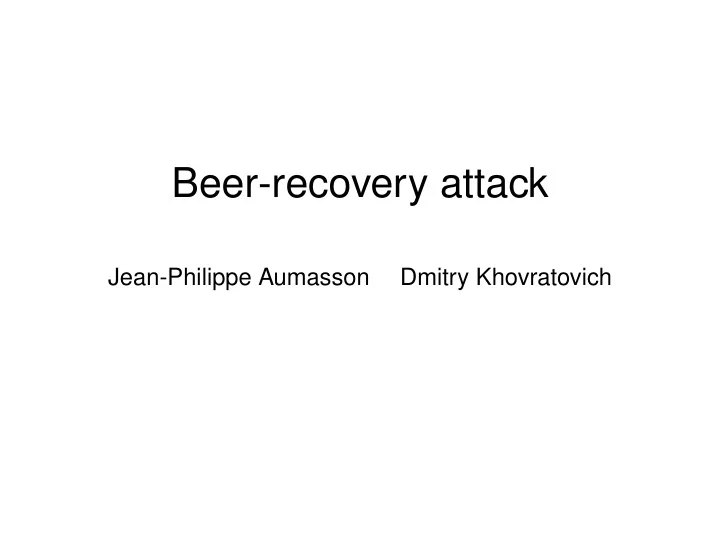

Beer-recovery attack Jean-Philippe Aumasson Dmitry Khovratovich
K ECCAK SHA-3 candidate
K ECCAK SHA-3 candidate Sponge with permutation K ECCAK - f [1600]
K ECCAK SHA-3 candidate Sponge with permutation K ECCAK - f [1600] No external cryptanalysis
K ECCAK SHA-3 candidate Sponge with permutation K ECCAK - f [1600] No external cryptanalysis A Trappist 25-beer award
K ECCAK SHA-3 candidate Sponge with permutation K ECCAK - f [1600] No external cryptanalysis A Trappist 25-beer award So we start...
CICO problem for K ECCAK - f [1600] K ECCAK - f [1600]: { 0 , 1 } 1600 �→ { 0 , 1 } 1600 18 rounds Constrained Input – Constrained Output (CICO) problem: Input 0 0 0 · · · ◮ Fix X , Y ⊂ { 0 , 1 } 1600 ◮ Find many x ∈ X , y ∈ Y : H f ( x ) = y 0 0 0 · · · ◮ Hard if X and Y are small Output
Triangulation tool ◮ View the transformation as a system of equations ◮ Fix some input and output bits to 0 ◮ Find solutions with complexity 1
Three rounds (of 18) can be attacked The tool is online: https://cryptolux.uni.lu/ mediawiki/uploads/0/03/Keccak-tool.zip
Algebraic analysis Bounds b on the degree given in the spec ( ⇒ cube tester in 2 b + 1 possible) Our result: heterogeneous algebraic structure even for small cubes
3 rounds, degree-2 cubes #components attacked = cube position
4 rounds, degree-9 cubes #components attacked = cube position
K ECCAK ’s doc conjectures 13 rounds enough against distinguishers Need 11 rounds for maximal degree. . . Open problem: how many rounds for a homogenous (reduced-degree) structure?
Truncated differentials First find ∆ in �→ ∆ out for θ − 1 with Hamming weight | ∆ in | = 1, | ∆ out | ≈ 1600 / 2 (conjectured optimal in the documentation) Used to find probability-1 truncated differential on 3 rounds
On four rounds, still large biases
Conclusions Inverse permutation more difficult to attack ◮ Faster diffusion ◮ Prob-1 differentials on 1 round only Results consistent with the designers’ analysis Good security margin The paper is online http://131002.net/data/papers/AK09.pdf
Recommend
More recommend